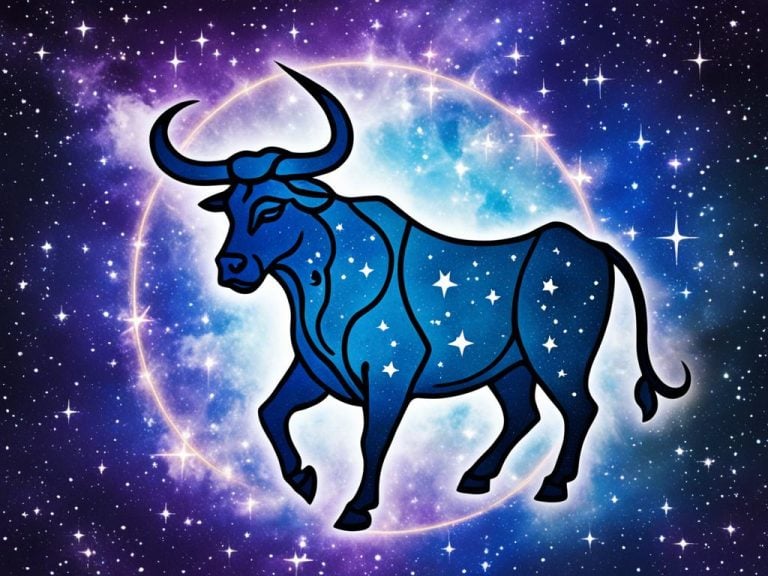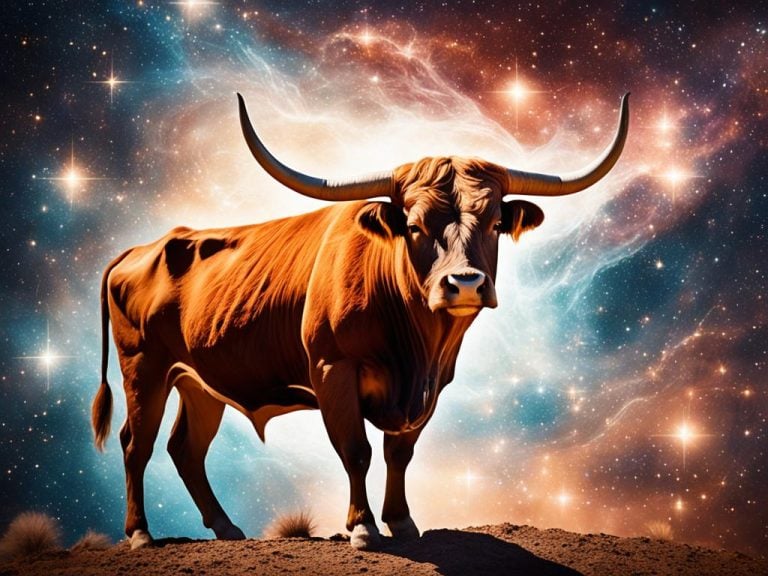Explore the Wonders of the Taurus Constellation
Did you know the constellation Taurus looks like a Bull and has been famous for ages? It’s inspired everyone from ancient people to today’s scientists. Join us on this adventure to learn about its past, meaning, and unique characteristics. We’ll discover the magic and secrets of the Taurus constellation together.
The History of the Taurus Constellation
The Taurus Constellation’s story goes way back to ancient times, making it very captivating. This star group is among the oldest known, with images of a bull in the sky. People drew these in caves during the Bronze Age, about 15,000 BC.
Both the Mesopotamians and Egyptians from long ago also looked up and saw the Constellation Taurus . They included it in their stories and beliefs. For the Mesopotamians, this area of stars stood for their god of farming and making things grow. In Egypt, they thought of it as the home of a special bull god named Apis.
These tales about Taurus show how much our early ancestors valued the stars. They used them as guides for knowing when to plant, grow, and celebrate. These ancient stories are still interesting to us today.
Roughly 2,000 years ago, a smart Greek called Ptolemy marked the Taurus stars on his sky map. He wrote about them in a famous book called “Almagest.” Thanks to his hard work, we still know and admire the Taurus Constellation today.

Learning about the Constellation Taurus is like taking a journey through time. We see what the sky meant to people long ago. From drawings on cave walls to stories and modern science, the Taurus stars keep on fascinating us.
Significance in Different Cultures
The constellation Taurus is very important in many cultures. This is true in Greek and Roman mythology the most. In Greek stories, Taurus is linked with the tale of Zeus. He turned into a bull to steal Europa, a Phoenician queen. This story is a big part of Greek culture, showing Zeus’ power and the change love brings.
In Roman myths, Taurus is about the god Jupiter becoming a bull too. He wanted Europa’s love. Jupiter is like Zeus in Roman culture. He brings power, authority, and change. The Taurus constellation reminds us of Jupiter’s strength and his ability to change to reach his goals.
These stories show the lasting importance of the Taurus constellation. It stands for power, strength, and how gods can change in both Greek and Roman cultures.
For those who want to know more about the Taurus constellation, there are great online sources. These include:
- Wikipedia: Offers a detailed article about the Taurus constellation, with its history and science.
- Constellation Guide: Helps explore the Taurus constellation’s details and traits.
Learning about the stories and meanings of the Taurus constellation shows its rich culture. It affects many civilizations throughout history.
Keep reading to find out more about the Taurus constellation’s interesting parts and wonders.
Features of the Taurus Constellation
The Taurus constellation is an awe-inspiring sight in the night sky. It’s famous for its beauty and stories. This makes it a fascinating part of the universe to explore.
In the first quadrant of the Northern Hemisphere, Taurus is easy to spot. You can see it at certain latitudes. Covering 797 square degrees, it’s the 17th biggest constellation. Its vast area means there are a lot of stars and other objects to see.
Taurus is surrounded by several other famous groups of stars. It’s next to Aries, Auriga, Gemini, Orion, and Perseus. Taurus is best known for the Hyades, a V-shape that looks like a bull’s face. This shape makes Taurus even more interesting to look at.

The brightest star of the Hyades is Aldebaran. It’s called the bull’s eye. This star makes Taurus very easy to find in the sky. Aldebaran is very bright, and this makes the Taurus constellation stand out.
The Pleiades is another amazing part of Taurus. It’s also called the Seven Sisters. These stars look stunning. The Pleiades has been a focus of stories and history for a long time.
For anyone interested in the stars, Taurus is a great starting point. Its size and special stars like the Hyades and the Pleiades make it unforgettable. Even if you’re just beginning to look at the sky, Taurus is a must-see.
The Hyades and Aldebaran
The Taurus Constellation is a thrilling part of the night sky. It includes the Hyades, the nearest open star cluster to us, about 153 light-years away. These stars look like they are moving together, creating a beautiful sight.
Aldebaran is a bright, orange star not far from Earth, about 65 light-years, and stands out in Taurus. Though not part of the Hyades, it looks connected because of where we see it from Earth.
The Hyades and Aldebaran make a stunning pair in the Taurus Constellation. The group of stars and the shining Aldebaran make this part of the sky even more interesting. They encourage people to look up and dream about the mysteries of space.
The closeness and brightness of the Hyades and Aldebaran are truly mesmerizing. They inspire us with their beauty. Next time you see the Taurus Constellation, stop and take in the detailed charm of the Hyades and the bright Aldebaran.
The Pleiades
The Pleiades, or the Seven Sisters, is a group of stars in the Taurus Constellation. It has several hot, blue, and very bright stars. The Pleiades is just 440 light-years away from us, which is quite close in space terms.
You can see the Pleiades just by looking up at the night sky. People have been fascinated by its beauty for centuries. It appears in ancient stories from around the world.
The Pleiades gets its name from Greek myths. The tale says they were once seven sisters. Zeus turned them into stars to protect them from Orion.
This star cluster is also important to science. It allows us to study how stars form and change over time. This is because the Pleiades is quite young, only about 100 million years old.
These stars aren’t just for scientists, though. Many people love looking at the Pleiades with telescopes. Its bright stars make it perfect for photos. You can see its beautiful details up close.
For the best view, go to a dark place outside the city. The dark sky highlights the Pleiades’ beauty. It reminds us of the vast and amazing universe we live in.

Observing the Taurus Constellation
The Taurus constellation looks amazing in the night sky. It’s very rewarding to see. The best time to see Taurus is in January and February. During these months, it’s high in the sky early in the evening. You can see its V shape easily, even where there’s a lot of light at night.
To see it best, choose a place with very little light around. Lights in cities can hide the stars. Going to a place away from the city with dark skies is better for seeing Taurus.
Want a closer look at Taurus? Try using a telescope or binoculars. They make the experience a lot better. Telescopes show stars, clusters, and nebulae up close. They give you detailed views. Binoculars let you see more of the sky at once. They’re also easier to hold for a long time.
It’s important to be patient when looking at the night sky. Let your eyes get used to the dark. Move slowly as you look up. Remember to take breaks and enjoy the view.
Are you into astronomy or just starting out? Don’t miss seeing Taurus. Spend an evening looking up. You’ll be amazed by what you see up there.
Additional Resources:
- To buy a star for someone in the Taurus constellation and learn about other celestial wonders, visit International Star Registry’s official website: International Star Registry.
- Explore the night sky with helpful tips and resources on stargazing equipment: Stargazing Guide.
Notable Events
The Taurus constellation is famous for its beauty and myths. Each year, it hosts the Taurids meteor shower from October to November. This show happens as Earth moves through the debris of comet Encke. The result is a night sky full of bright meteors. These meteors are bright, last long in the sky, and seem to move slowly.
If you get a chance to see the Taurids, you’ll see a breathtaking sight. The best time to look is on the nights of the 11th and 12th of November for the North Taurid meteor shower. For the South Taurid shower, the best nights are the 9th and 10th of October 2019.
Another exciting event is the occultation of Aldebaran, the brightest star in Taurus. This happens when the Moon covers Aldebaran, making it disappear for a short time. Then, the star emerges again, like magic. This event can be seen from specific places on Earth and is a rare treat to witness.
For more about the Taurus constellation and its amazing events, visit Sea and Sky, AstroBackyard, and James Webb Discovery.
Did You Know?
Did you know that the Taurus zodiac symbol and the Taurus astronomical group are connected? It’s fascinating how celestial bodies and their symbolism have influenced astrology and our understanding of the zodiac signs. Taurus, in astrology, is represented by the Bull, a symbol of strength and determination.
The Taurus constellation, part of the Taurus astronomical group, is one of the oldest recognized constellations in the night sky. It is home to the bright star Aldebaran and a cluster of other celestial bodies. These stars have captured the imagination of people for centuries, providing inspiration for myths and legends.
What’s even more intriguing is that the Taurus celestial body, as explored by astronomers, goes beyond just a simple constellation. It includes various nebulae and galaxies within its boundaries, such as the Pleiades and Crab Nebula. This showcases the vastness of space and the galaxies that make up our universe.
So the next time you gaze up at the night sky, take a moment to appreciate the connection between the Taurus zodiac symbol, the Taurus astronomical group, and the Taurus celestial body. It’s a reminder of the deep intertwining of science, mythology, and our human fascination with the stars above us.
- The Taurids meteor shower appears to radiate from the general direction of the Taurus constellation, adding to its allure.
- The Pleiades, an open star cluster within Taurus, is a breathtaking sight with about 500 stars. Six of these stars, named after the daughters of Atlas, are visible to the naked eye.
- Taurus is bordered by Aries, Gemini, Perseus, Auriga, Orion, Eridanus, and Cetus in the night sky, creating a stunning celestial neighborhood.
Immortalizing Your Legacy: Name a Star in the Sky
Imagine having a star in the Taurus constellation bearing your name or that of a loved one, a timeless tribute to cherish for generations to come. With International Star Registry, you have the opportunity to immortalize your own legacy by naming a star within the celestial confines of Taurus.
Naming a star is a heartfelt gesture that transcends time and space, making it the perfect gift for birthdays, Christmas, anniversaries, or any special occasion. Whether it’s to honor a cherished memory, celebrate a milestone, or simply express love and appreciation, buying a star in the Taurus constellation is a unique and meaningful way to leave a lasting imprint on the cosmos.
This constellation is a favorite among celebrities. Some celebrities that have their very own stars named in Taurus include Dwayne “The Rock” Johnson, Eric Burdon, Amy Adams, and George Carlin.
Conclusion
The Taurus constellation is a wonder in the night sky. It draws people in with its story, special traits, and myths. This area covers about 797 square degrees. It shows a beautiful array of stars, with Aldebaran shining bright like the “Eye of the Bull”.
Seeing Taurus is amazing in the winter for those in the north. Its grand appearance lights up the sky. Astronomers and stars alike are charmed by this cosmic figure. It even has stars named for famous people, such as Dwayne “The Rock” Johnson and George Carlin.
This constellation has deep roots in ancient stories and current culture. In ancient Greece, it was the Tauros star group, showing qualities of strength and determination. Other cultures, like those in Arabia, Syria, and China, have their own tales of this star region.
If you’re intrigued by the myths and meaning of Taurus, click the links below:
Name a star after someone in the Taurus constellation
Constellations of Words: Taurus
Look up and enjoy the beauty and tales of the Taurus constellation. Let it spark your imagination with its enduring charm and stories.
FAQ
What is the Taurus constellation?
The Taurus constellation is an important group of stars in the sky. It looks like a bull. It is linked to the Taurus zodiac sign.
What is the history of the Taurus constellation?
The Taurus constellation’s story goes back to the Bronze Age. People first saw it in caves around 15,000 BC. The 2nd-century astronomer Ptolemy then included it in a list of 48 constellations.
What is the significance of the Taurus constellation in different cultures?
Zeus in Greek myth and Jupiter in Roman myth turned into a bull for different reasons. Both stories highlight the constellation’s themes of strength and change.
What are the features of the Taurus constellation?
Taurus is in the sky’s first quadrant of the Northern Hemisphere. It’s best seen at certain spots on Earth. The Hyades and Pleiades star clusters are part of it.
What are the Hyades and Aldebaran in the Taurus constellation?
The Hyades form a V shape that shows the bull’s front. Aldebaran, an orange giant, marks the bull’s eye. They make a cool sight even though they’re not really close together in space.
What is the Pleiades in the Taurus constellation?
The Pleiades is a group of hot, blue stars in Taurus. It looks like a tiny dipper. It’s close to us in space.
When is the best time to observe the Taurus constellation?
Look for Taurus in January and February. It stands out in the evening sky. You can see it well, even in bright city lights.
What are some notable events related to the Taurus constellation?
In late October to November, watch the Taurids meteor shower. You can also see the Moon hide Aldebaran sometimes. These are cool to watch from Earth.
Why is the Taurus constellation significant?
Taurus is special because of its long history, unique looks, and cultural meanings. It teaches us about the sky and ancient stories.
Source Links
- 100 Fascinating Facts about the Taurus Constellation – https://www.jameswebbdiscovery.com/universe/100-fascinating-facts-about-the-taurus-constellation
